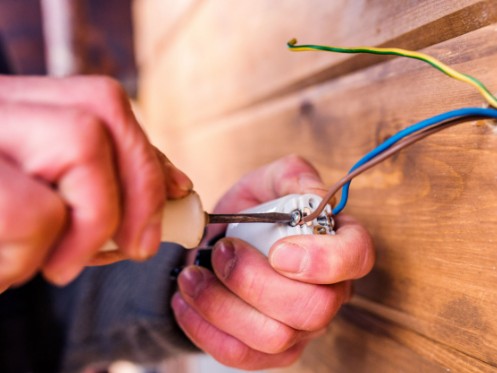Electrical outlets and circuit breakers are both important parts of electrical wiring systems. They are both used to protect against hazardous electrical surges and shorts. However, there are some differences between a circuit breaker and a ground fault circuit interrupter, or GFCI. Below, we look at each breaker type in more detail and compare them.
What Is a Circuit Breaker?
A circuit breaker is an electrical switch that breaks a circuit when it detects an overload or a short. This helps to protect the wiring and components from overheating or becoming damaged. Circuit breakers are typically used in homes and buildings with large amounts of electricity branching out into different lines.
Circuit breakers are sometimes used with fuses, which act as backup protection in the event of an overload. If the breaker were to become tripped, the fuse would protect the wiring and other components from damage.
What Is a GFCI Receptacle?
A ground fault circuit interrupter (GFCI) receptacle is an electrical outlet with a built-in circuit breaker. It shuts off the electricity when it detects an imbalance or overcurrent in the electrical flow. This helps to prevent electrocution and other electrical hazards. The National Electrical Code requires GFCI receptacles for all outdoor outlets and any outlet near a water source, such as a kitchen or bathroom. Installing GFCI receptacles can help protect your family’s safety and reduce the risk of electrical fires.
Differences Between Circuit Breakers and GFCI Receptacles
While these two types of breakers serve similar purposes, they have some key differences. Here are some of the differences between circuit breakers and GFCI receptacles:
Usage
Circuit breakers are typically used in commercial and industrial applications. GFCI receptacles are mostly used in homes and other residential settings, along with circuit breakers in your home’s electrical panel. This is because circuit breakers are more reliable and effective in preventing electrical faults, while GFCIs provide only a basic level of protection. Circuit breakers need to be manually reset after a fault, while most GFCIs will automatically reset themselves.
Also, circuit breakers are particularly useful for large electrical systems, where it can be difficult to quickly identify the cause of a fault.
Purpose
The main purpose of a circuit breaker is to prevent an overload or short circuit from damaging wiring. GFCIs are designed to protect against electrocution and other hazards. In addition to protecting against overloads and shorts, GFCIs also detect small imbalances in electrical current. This issue can be caused by faulty wiring or damaged appliances.
Installation
Circuit breakers are installed in a main breaker box outside the home or building. GFCI receptacles can be installed in any outlet box and can be found near water sources or outside. GFCI receptacles can also be installed directly into the wiring of the home or building, allowing them to detect even the slightest change in electrical current. A qualified, licensed electrician is required to complete the installation of circuit breakers and GFCI receptacles.
Both circuit breakers and GFCI receptacles are designed to protect against electrical faults and fire hazards, but they have some key differences. If you need help installing or upgrading your electrical system in South Central Texas, it is best to consult a professionally licensed electrician like those at GVEC Electrician Services. We can provide the best advice on which type of breaker or receptacle is best for your specific needs. We can also help you with electrical wiring, electrical upgrades, interior lighting, exterior lighting, electrical inspections and surge protection. Contact GVEC Electrician Services today to set up an appointment.



